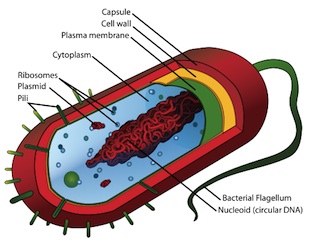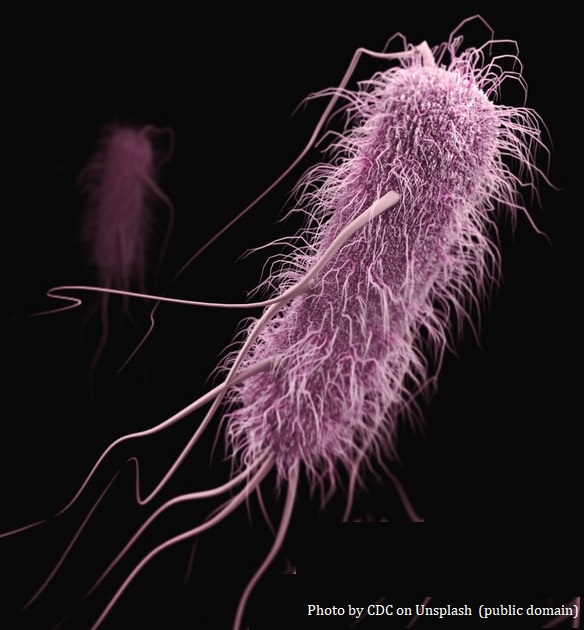Prokaryote cell structure & function
 Learning activities to help students draw cell diagrams
Learning activities to help students draw cell diagrams
This activity includes; a full set of resources for teaching about prokaryotes, a student activity sheet, with examiner's hints, a short screencast explaining how to draw a prokaryote cell,flashcards to help students' learn the prokaryote labels,a quick test of the labels & IB style questions, with answers and as an extension activity an arcade game to further consolidate learning.
There are ten times more prokarote cells than there are human cells in an IB student's body! Fact check here.Ref: American Society for Microbiology. "Humans Have Ten Times More Bacteria Than Human Cells: How Do Microbial Communities Affect Human Health?." ScienceDaily, 3 Jun. 2008. Web. 4 Jul. 2012
Lesson Description
 Guiding Question
Guiding Question
How sure can a Biologist be when they illustrate the structures of prokaryote cells?
Prokaryotes are so small that they are barely visible in light microscopes, even to the trained eye of the microbiologist?
Which types of new technology might have helped?
Activity 1: Screencast
Play this screencast ![]() How to draw a prokaryote cell for IB Biology
How to draw a prokaryote cell for IB Biology
and complete the ![]() Prokaryote diagram student worksheet.
Prokaryote diagram student worksheet.
Look at this clear detailed microscope image of real prokaryote E.coli cells which show the same features.
Activity 2: Learn the labels
Study the ![]() diagram label flashcards and then try one of the online activities with the quizlet cards below.
diagram label flashcards and then try one of the online activities with the quizlet cards below.
Activity 3: IB Style questions
![]() Quick test - questions to test knowledge of the labels
Quick test - questions to test knowledge of the labels
Test understanding with these ![]() IB style questions
IB style questions
Teachers' notes
This page is part of a series of lesson resources for the diagrams of the IB syllabus.
There are many ways to use this page. Students can work independently or the resources can be projected in the classroom. Worksheets allow you to print as much or as little as you wish. The online activities can be guided or let the students choose. The choice is yours.
Answers to the questions can be found in the resources section. Teachers can makes these separate pages available to students once the questions are completed.
A Suggested Lesson Plan.
Starter: 10 minutes
- Students complete the Diagram Activity worksheet while watching the Screencast as a whole class.
Main: 40 minutes
- Students study printed (or online) Flashcards to help memorizing of the labels
- Students take a Quick test - to see how well they understand the labels
- Students review the Screencast and attempt the diagram (with labels) from memory.
End: 10 minutes
- Plenary - students play the arcade game to further consolidate learning
- Differentiation - students who need additional time for main can continue independently.
Homework
Complete the IB style questions.
Interesting extension
Following a comment from Anthony Rose I have recently adjusted the description of prokaryote flagella to include name of the protein flagellin and to remove any mention of microtubules.
I have learned that E.coli produces approximately four tubular filaments at one pole of the cell. These flagella filaments can change shape and can rotate independently in both clockwise and anticlockwise directions thanks to an ingenious microscopic motor made from an assemblage of a few dozen proteins. E.coli can thus change direction as is moves.
It is thought that the Eukaryote and the Prokaryote flagella are an example of convergent evolution (useful in topic 5) and that there may be a third type of flagella in the Archea (the other Domain in classification of organisms!)
There is even a theory that flagella could be an example of endosymbiosis and there is an ongoing debate about the 'irreducible complexity' of flagella. The idea that without just one protein, a flagella stops working, so it could be evidence that evolution by natural selection couldn't have happened. However, evolutionary scientists refute these claims citing several mechanisms which are possible.
For more information I can recommend:
- An easily readable online book E.Coli in motion by Howard C. Berg
- A short summary of Eukaryote and prokaryote flagella on Quora by Akshari Gupta, PhD
- Great movies from Howard C Berg's site at Harvard

 IB Docs (2) Team
IB Docs (2) Team
